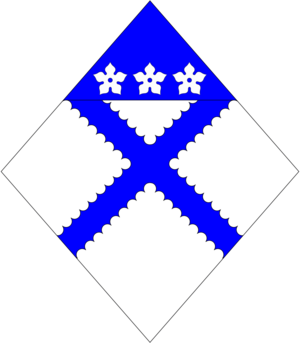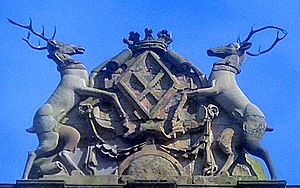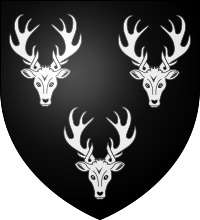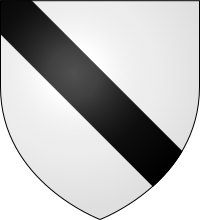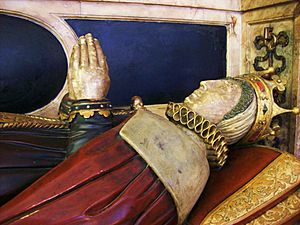Bess of Hardwick facts for kids
Quick facts for kids Bess of Hardwick |
|
|---|---|
| Countess of Shrewsbury | |
| Bess of Hardwick, Countess of Shrewsbury, by Rowland Lockey, 1592 in the collection of the National Portrait Gallery, London | |
| Spouse(s) | Robert Barley Sir William Cavendish Sir William St Loe George Talbot, 6th Earl of Shrewsbury |
| Issue | |
| Frances Cavendish Temperance Cavendish Henry Cavendish William Cavendish, 1st Earl of Devonshire Charles Cavendish Elizabeth Stuart, Countess of Lennox Mary Talbot, Countess of Shrewsbury Lucrece Cavendish |
|
| Noble family | Hardwick |
| Father | John Hardwick |
| Mother | Elizabeth Leeke |
| Born | c. 1521 |
| Died | 13 February 1608 |
| Burial | All Saints Church, Derby |
Elizabeth Cavendish, later known as Elizabeth Talbot, Countess of Shrewsbury (born around 1521 – died 13 February 1608), was a very important person in English society during the time of Queen Elizabeth I. She was often called Bess of Hardwick, named after her home, Hardwick Hall in Derbyshire.
Bess became incredibly rich and powerful through her four marriages. She was also a smart businesswoman. She grew her wealth by investing in things like mines and glass-making.
She was married four times. Her first husband was Robert Barley. Her second was Sir William Cavendish. Her third was Sir William St Loe. Her last husband was George Talbot, 6th Earl of Shrewsbury. He was the guardian of Mary, Queen of Scots, who was held captive.
Bess was very skilled at needlework. She spent time with Mary, Queen of Scots, at Chatsworth House in 1569, 1570, and 1571. During these times, they worked on embroidery projects together, like the Oxburgh Hangings.
In 1601, Bess made a list of all the furniture and textiles in her three homes: Chatsworth, Hardwick, and Chelsea. This list still exists today. In her will, she made sure these items would be kept by her family forever. This collection, known as the Hardwick Hall textiles, is the largest collection of old tapestries and embroideries from one private family.
Bess is also famous for her building projects. The most well-known are Chatsworth House, which is now home to the Dukes of Devonshire (who are descendants of her second marriage), and Hardwick Hall.
Contents
Bess of Hardwick's Early Life
Elizabeth Hardwick was the daughter of John Hardwick and Elizabeth Leeke from Derbyshire. We don't know her exact birthdate, but it was between 1521 and 1527. She said in court in 1546 that she was "of tender years" (under 16) when she first married in 1543. This suggests she was born around 1527.
Her family, the Hardwicks, came to Derbyshire in the 1200s. By the 1400s, they were respected landowners. Bess was born into this family, which was not very high in society. However, her fourth marriage to the Earl of Shrewsbury in 1567 made her a "countess." After her husband died in 1590, Bess became one of the richest women in England. She then built her most famous home, Hardwick New Hall, which was finished in 1599.
John Hardwick died when he was about 40. He left behind his wife, a son, and four daughters. His widow, Elizabeth Leeke, later married Ralph Leche.
Not much is known about Bess's very early life. She likely married her first husband in 1543. There's a story that she lived in London with Lady Zouche, a noblewoman, when she was 12. However, there is no real proof for this story. It is possible she worked for the Zouche family in Derbyshire after her first husband died.
Bess's Four Marriages
First Marriage
In 1543, Bess married Robert Barley (or Barlow), who was 13 years old. He was the heir to a nearby estate. They probably married in May 1543, just before Robert's father died. There is no evidence they lived together as husband and wife. Robert died in December 1544, and they had no children. This marriage was arranged to protect Robert's family land.
After Robert died, Bess had to fight in court to get her share of his estate. She won her case and received compensation several years later.
Second Marriage
On August 20, 1547, Bess married Sir William Cavendish. He was the King's Treasurer and had been married twice before. Bess became Lady Cavendish. The wedding happened very early in the morning at the home of the Grey family, who were friends of the couple. Sir William was much older than Bess and had two daughters.
Sir William had become wealthy after the King closed down monasteries. He was able to buy many properties for himself. Bess may have advised him to sell his lands in southern England and buy the Chatsworth estates in her home county of Derbyshire.
Sir William Cavendish died on October 25, 1557. Bess was a widow again and owed a lot of money to the Crown. Before he died, Bess made sure that his land would be passed down to their children.
Bess and Sir William had eight children, but two died when they were babies:
- Frances Cavendish (born 1548), married Sir Henry Pierrepont. Their children included Robert Pierrepont, 1st Earl of Kingston-upon-Hull.
- Temperance Cavendish (born 1549), died as a baby.
- Henry Cavendish (born 1550), Queen Elizabeth I was his godmother. He married Grace Talbot. Bess called him "my bad son Henry" because he tried to help his niece Arbella Stuart escape.
- William Cavendish, 1st Earl of Devonshire (born 1552), his descendants became the Dukes of Devonshire.
- Charles Cavendish (born 1553), Queen Mary I of England was his godmother. He married Catherine Ogle. Their son was William Cavendish, 1st Duke of Newcastle-upon-Tyne.
- Elizabeth Cavendish (born 1555), married Charles Stuart, 1st Earl of Lennox. They had a daughter, Lady Arbella Stuart.
- Mary Cavendish (born 1556), married Gilbert Talbot, 7th Earl of Shrewsbury. They had five children, including Lady Alatheia Talbot.
- Lucrece Cavendish (born and died 1556), likely Mary's twin.
Third Marriage
In 1559, Bess married for the third time to Sir William St Loe (1518–1565). She became Lady St Loe. Her new husband was the Captain of the Guard for Queen Elizabeth I. He was able to help Bess pay off her large debt to the Crown.
Sir William owned large estates in the west of England. When he died unexpectedly in 1564 or 1565, he left everything to Bess. This was unusual because he had daughters and a brother. Bess was now responsible for his two adult daughters from his first marriage, but they were already well taken care of.
Sir William St Loe's death made Bess one of the wealthiest women in England. She was still in her late 30s, looked good, and was healthy. Many important men wanted to marry her.
Fourth Marriage
Bess waited until 1568 to marry for the fourth time. She married George Talbot, 6th Earl of Shrewsbury, becoming Countess of Shrewsbury. He was one of the most important noblemen in England and had seven children from his first marriage.
In a special double wedding in February 1568, two of his children married two of hers. Bess's daughter Mary Cavendish, aged 12, married Shrewsbury's eldest son Gilbert, aged 16. At the same time, Bess's son, Sir Henry Cavendish, aged 18, married Shrewsbury's daughter Lady Grace Talbot, aged 8.
Just before Bess and the Earl of Shrewsbury married, there was a big political event in Scotland. Mary, Queen of Scots, was imprisoned by Scottish lords and forced to give up her throne. In May 1568, Mary escaped and fled to England, hoping Queen Elizabeth would protect her.
Queen Elizabeth felt she had to protect Mary, who was her cousin. However, Mary also claimed the English throne, so Elizabeth saw her as a threat. Elizabeth decided to keep Mary under guard. Mary was eventually placed in the care of the Earl of Shrewsbury and his wife, Bess. This was like a house arrest for Mary.
Mary arrived at her new home, Tutbury Castle, in February 1569. She was 26 years old and would stay with Shrewsbury and Bess for 15 years. Queen Elizabeth made Shrewsbury pay for Mary's upkeep. It was said that Mary tried to cause problems between Bess and her husband, even suggesting to the Earl that Bess was stealing. Mary's presence, along with the costs and political stress, likely caused problems in Shrewsbury and Bess's marriage.
While Mary was with the Earl and Countess, she lived in several of their homes in the Midlands, including Tutbury, Wingfield Manor, Chatsworth House, and Sheffield Manor. During this time, Bess often spent time with Mary, working on embroidery and textile projects together. All of Mary's needlework later became part of Bess's famous collection at Hardwick Hall.
Bess joined Mary at Chatsworth for long periods in 1569, 1570, and 1571. They worked together on the Oxburgh Hangings.
Shrewsbury and Bess separated for good around 1580. Even Queen Elizabeth tried to get them to make up. Mary, Queen of Scots, seemed to make their problems worse by playing them against each other. Bess spread rumors that her husband had been too close to Mary, but she later took back this accusation.
When the Earl of Shrewsbury died in 1590, Bess became the Dowager Countess of Shrewsbury. She lived mostly at Hardwick, where she built the new mansion, Hardwick Hall. This building was so famous for its many large windows that people made a rhyme: "Hardwick Hall, more glass than wall." Bess was one of the greatest builders of her time, also working on Chatsworth House and Oldcoates.
The Stuart Connection
In 1574, Bess arranged a marriage for one of her daughters. Her daughter, Elizabeth Cavendish, married Charles Stuart, 1st Earl of Lennox. This was a very important marriage for Bess. Charles Stuart was the son of Margaret Douglas, who was a member of the royal family. Margaret Douglas was the daughter of Margaret Tudor, who was the sister of King Henry VIII and Queen Elizabeth's first cousin.
Charles Stuart was also the first cousin of Mary, Queen of Scots. This marriage meant that any children Bess's daughter had would have a claim to the English throne.
This marriage happened without the Earl of Shrewsbury knowing, and Queen Elizabeth was not asked for her permission. Because the Lennox family had a claim to the throne, this marriage was seen as potentially dangerous to the Queen.
The Countess of Lennox, Charles Stuart's mother, was sent to the Tower of London for several months. Bess was ordered to London for an official investigation, but she stayed in Sheffield until the trouble passed.
The child of this marriage was Arbella Stuart. Arbella had a claim to the thrones of Scotland and England. She was the second cousin to King James VI of Scotland (who later became King James I of England).
Arbella was sometimes invited to Queen Elizabeth's court, but she mostly lived with her grandmother, Bess. Bess really wanted Arbella to become Queen. She even kept Arbella close to prevent her from marrying someone unsuitable. Arbella blamed her grandmother for this. They had a big falling out when Arbella tried to run away and marry a man who also had a claim to the throne. Bess then removed Arbella from her will and asked the Queen to take her granddaughter away.
Arbella's claim to the throne was never officially recognized. Even though Bess removed Arbella and her eldest son Henry from her will, she later made up with Arbella a little. Since 1952, the British royal family has been descended from Bess. Queen Elizabeth II was a descendant of Bess through the Dukes of Portland.
In 1604, Bess worked with Queen Anne to try and start a college or university in Ripon, Yorkshire. This plan was promoted by Cecily Sandys, the widow of Bishop Edwin Sandys.
Death and Burial
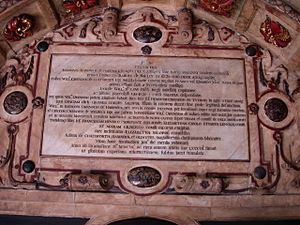
Bess of Hardwick died at 5 PM on Saturday, February 13, 1608, when she was 81 years old. When she died, she was still "one of the richest, and most powerful women in the kingdom." On February 16, her body was placed in a special burial place in All Saints Church, Derby. This church is now Derby Cathedral. She had already arranged for an impressive monument with a praising message to be put up during her lifetime. This monument and statue still exist today. The stories that her body lay in state for weeks at Hardwick Hall are not true. Her large estates were left to her children from her second marriage.
Images for kids


